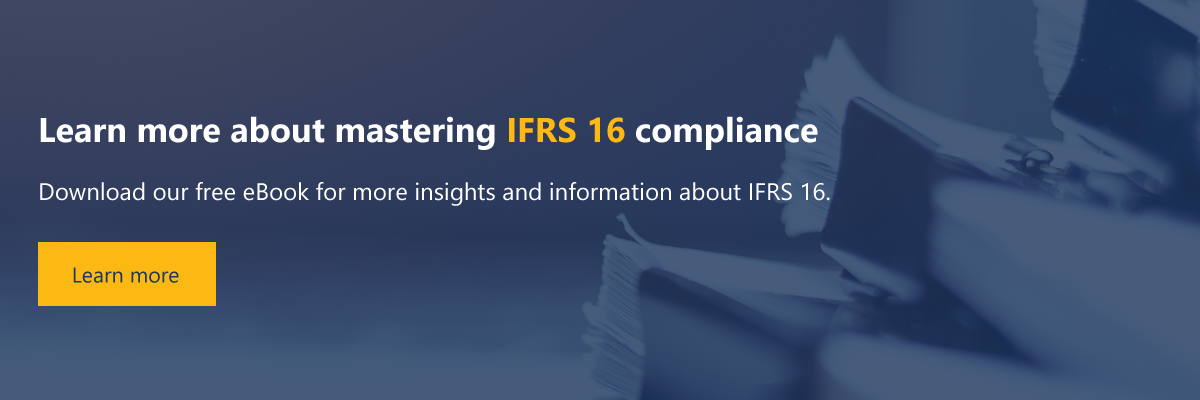Many companies struggle to implement IFRS 16 in a way that enables long-term compliance. You may be so busy scrambling to meet deadlines that future compliance is far from your mind. Usually, there’s little time to set-up the right processes and systems to make sure the bulk of the work is automated and accurate for future years. But what if you didn’t leave accounting standards to the last minute? It’s possible to set-up futureproof systems and processes that not only implement the new accounting standard but help you to maintain it.
In a previous blog, we outlined the changes companies face under IFRS 16. We recommend digging into that content before you get started with these simple steps. In this particular blog, we specifically outline a step-by-step approach to help you implement IFRS 16 and maintain best practices so that long-term compliance with the accounting standard is achievable. There’s a lot to cover, so let’s jump right in.
Step 1: create a team who focus on lease accounting compliance under IFRS 16
Every major project needs to be managed, and implementing IFRS 16 is no exception. Select a team responsible for managing the transition process. Responsibilities will include setting timelines and making sure all those contributing data observe best practices. Ideally, establish this team with a view to not only implementing processes for IFRS 16 but maintaining and improving those processes over time.
Step 2: get your entire company onboard and budget appropriately
Now that you’ve chosen the team responsible for managing the project, it’s time to get every other resource on board. Every department in your organization may see the impact of the new accounting standard. From IT to investor relations, every department needs to be involved.
After each team has reviewed the implications of the new accounting standard, it will be necessary for the entire company to predict how it will impact workloads. You will also need to budget appropriately for both resources, time, and costs. Implementing the IFRS accounting standard takes time, and so too will maintaining compliance. One of the trickiest parts of the compliance puzzle is factoring in already busy teams’ work schedules.
Step 3: gather all your current lease information and organize it
It’s time to break into the filing cabinets. You need to thoroughly inspect and understand your leases, lease terms, renewal options and payments. Examine each lease or class of lease. Be prepared to identify and account for each component as a separate lease in multi-asset leases. Ensure you understand the lease and non-lease elements and watch out for “embedded leases” in other contracts.
Step 4: evaluate your company’s current leasing policies under IFRS 16 changes
IFRS 16 presents new challenges and complexities for lessees, including an increased administrative burden on your team. Review your current leasing policies with a view making appropriate changes to both processes and systems. If you’re unsure what the differences might be, read our blog on IFRS 16 compliance changes here.

Step 5: conduct a lease versus buy analysis on all leases for long-term insights
Now that you have a better understanding of IFRS 16 and how it impacts your company’s leases, you may even want to run a lease versus buy analysis. The analysis will give you clear insights into the value of your properties over time. It can also act as a control to ensure that your lease portfolio is complete.
Under IFRS 16, leases depreciate over the term of the lease. As a result, the return on assets may look worse as a finance lease than as an operating lease in statements. However, a lease versus buy analysis should allow you to give a fuller picture of the value over time.
Step 6: build a report library to automate the necessary reports
A reports library is key to maintaining compliance and tracking your leases over time. Build a system that allows you to analyze leases, assets, and obligations at the click of a button. Some companies rely on a complex network of spreadsheets to manage this.
However, it’s best practice to invest in a lease accounting software that will enable you to ensure all data is accurate. Automation of reports increases the visibility and traceability of information, which will be critical for any company hoping to remain compliant under IFRS 16.
Step 7: make sure you’re investing in the right technology
Once you try to create a reporting system that will track data and automate reports, it may become apparent that your current software is not up to the task. Most software is unable to manage the specific complexities presented by IFRS 16. For most companies, it’s worthwhile investing in lease accounting software that integrates fully with current systems.
Find lease accounting software that extends the functionality of your current software. Appropriate software is preferable to trying to reinvent the wheel and work between siloed systems. One of the big mistakes companies make is trying to move sensitive and complex data between multiple systems. Usually, this results in an administrative nightmare. Often, proving compliance can become a convoluted process riddled with errors.
Recommended reading: Top 8 essential commercial lease management software features
Step 8: Implement processes that manage the end-of-term
In most lease accounting software, this functionality is automated. However, if you choose to stick with spreadsheets, you’re going to want to set up processes to keep a close eye on the end-of-term leases. Not only will you need to notify users of the end of leases, but also create options to help lessees speed up renewal decisions. Usually, you will want lessees to make this decision before the end-of-term. It will also be necessary to implement procedures for cancellations and returns of equipment or property.
Step 9: long-term maintenance of accuracy and completeness of your database
Implement strategies to effectively onboard new leases, and decide how the data from these leases will be recorded and processed going forward. It may sound simple, but many companies fail with the long-term maintenance of a clean database. It takes time and resources to ensure procedures are followed correctly.
Due to the decentralization of many companies, it is best practice to invest in a centralized system. This will enable your company to adhere to the same accounting standards across the board.
Step 10: schedule your roll out to implement IFRS 16
Rolling out an effective IFRS 16 implementation takes time, resources and a lot of information. By thinking about the previous steps, you will now be in a position to plan just how long it will take to manage a company-wide rollout of the new accounting standard.
Take into account the current workloads of all involved; the tools at your disposal; the systems that might effectively take care of the bulk of the workload; training your team; designing processes and internal standards for data collection; and communicating these processes and standards to the team at large. It’s a lot! But by breaking it down into manageable steps, there’s no reason it’s not achievable.
Step 11: start now
There’s no time to lose. Implementation of the IFRS 16 accounting standard should be considered a priority for any company managing leases. It requires resources, planning, company-wide cooperation, and time.
Please don’t underestimate the amount of time it will take your team to implement IFRS 16. It’s likely to take several months to work through the planning of processes and evaluating current leases. It will then take several more to find the system that works best for your lease portfolio and integrates with your current system. Several more months will be required to train users and establish best practices. It all adds up, so it’s best to get started as soon as possible.
Continued reading: Avoid these 7 common lease administration mistakes



